ツイーターとは?ツイーターは何をしますか?ツイーター スピーカー ガイド
優れたサウンドのスピーカー システムは、ツイーターを含む数種類のスピーカーで構成されています。しかし、ツイーターとは何ですか?ツイーターは何をしますか?
この包括的な投稿では、ツイーター スピーカーの機能、さまざまなスピーカー ドライバーの素材、最高のサウンドなどを紹介します!
インフォグラフィック – ツイーターの事実
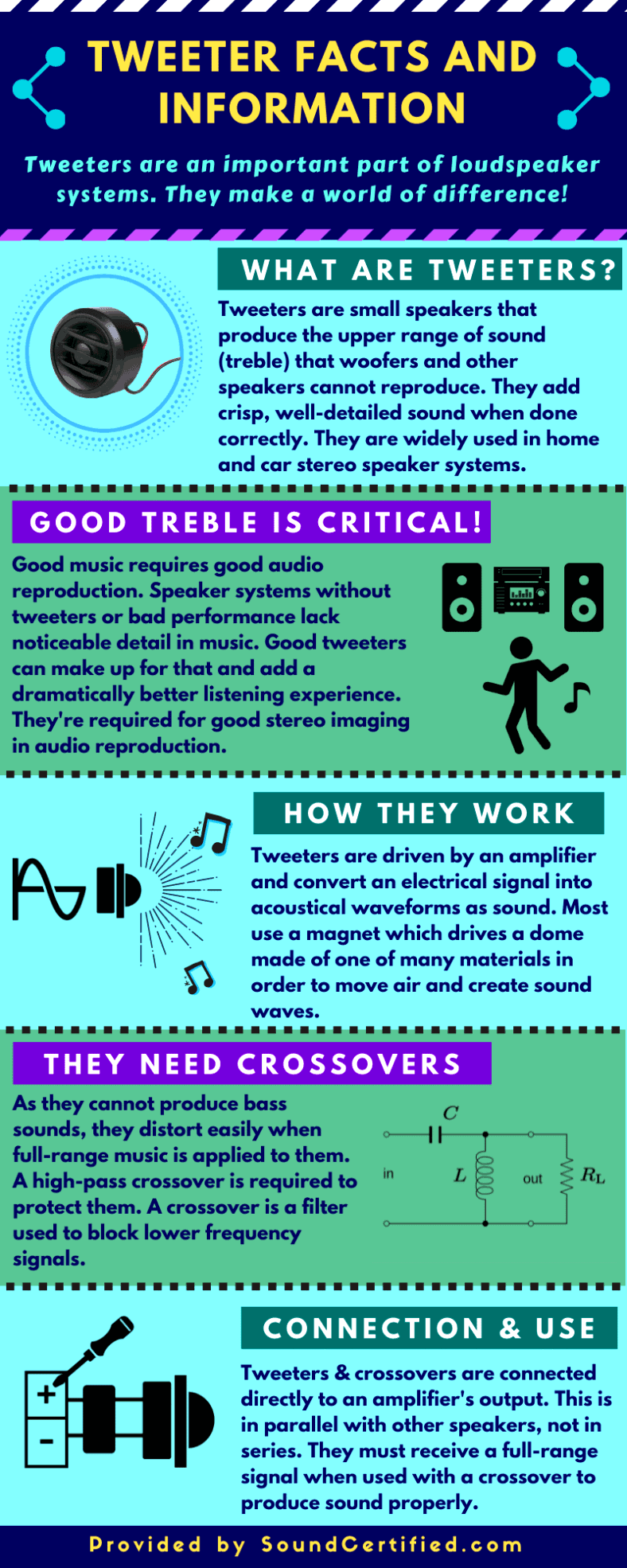
ツイータースピーカーとは?
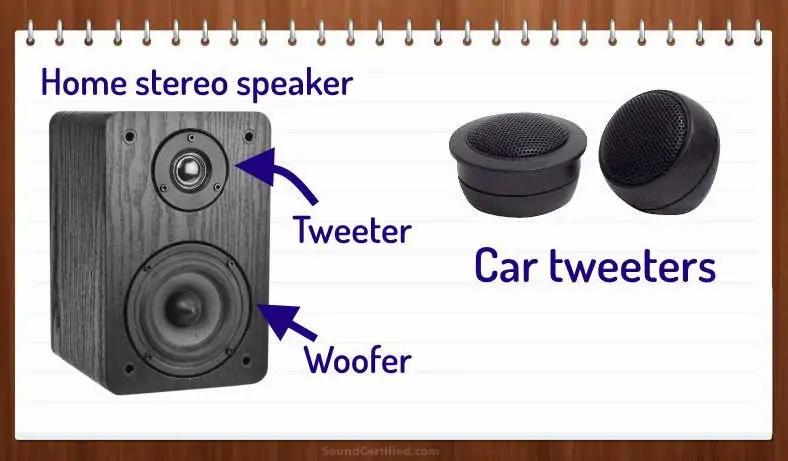
ツイーターは、音楽で聞こえる高音域を生成するスピーカーです。音の周波数が高いほど音波が小さくなるため、そのサイズは、一緒に使用する他のスピーカーよりも小さくなります。
ツイーターは、高音 (高周波数) の音楽範囲で音と音楽を生成する一種の電気機械ラウドスピーカーです。ウーファーや、2 ウェイ ブックシェルフ スピーカー ペアの設計で使用されるような高音を生成できないスピーカーを補完します。
ツイーターは小さい音波を生成し、小さなコーンを持っているため、サイズが小さいです。一般的に言えば、リスナーに向けたときに最もよく使用されます。
ほとんどは、特定のスピーカーの制限にもよりますが、最大 3 キロヘルツから 20 キロヘルツ (kHz) などの特定の範囲に制限されています。人間の聴覚の典型的な範囲は、約 20 Hz から 20 kHz です。
キロヘルツは、生成される音の周波数またはオーディオ信号波形の 1 秒あたりのサイクルを表すために使用される用語です。
ツイーターの基本パーツ
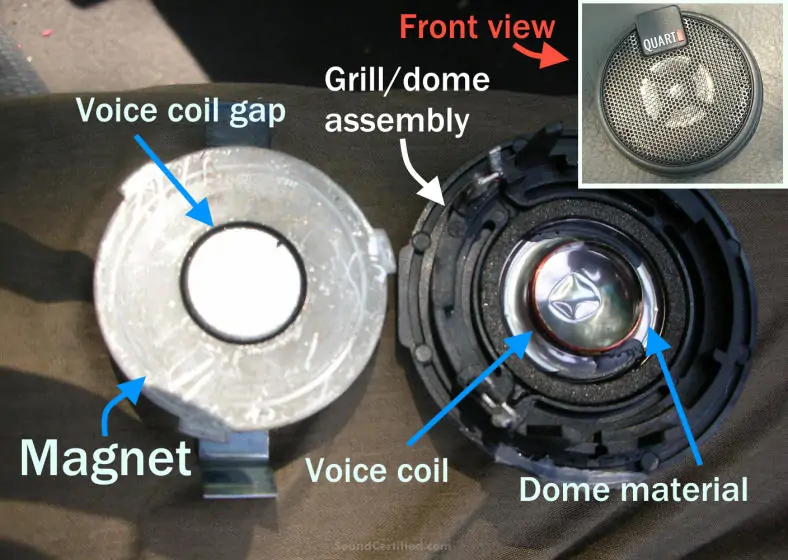
分解された車のツイーターの画像。マグネット アセンブリ (左) とドーム/グリル/配線端子アセンブリ (右) が示されています。ボイスコイルはドームの後部に取り付けられています。この画像では、ドームは銀色の素材でできています。ほとんどの場合、マイラーまたはその他の種類のプラスチックまたはその他の軽量素材です。
典型的なツイーターの設計は (他にもさまざまなタイプが存在しますが)、内部に円形のギャップを持つ小さな磁石で構成されています。ボイスコイルと呼ばれる銅線を巻いたボイスコイルが、さまざまな素材で作られたスピーカードームに取り付けられています。それらは、下向きの角度の付いたコーンを使用する他のスピーカーとは異なり、ほとんどが外側に湾曲した湾曲したドーム形状を使用するという点で異なります.
このアセンブリは、磁石の隙間に挿入されて吊り下げられます。ドームは、他のラウドスピーカーと同様に、柔軟で硬い素材によって側面が支えられています。
ツイーターは何をしますか?
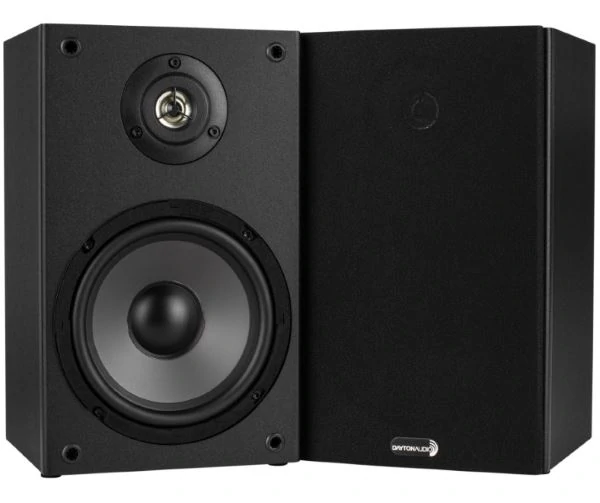
良い音楽を楽しんでいますか?ツイーターは、どこにでもあるサウンドシステムで優れた音楽を可能にします。これらのデイトン B652 ブックシェルフ スピーカーのようなホーム ステレオ スピーカーは、安価で効果的なツイーターを使用して、ミッドレンジ スピーカーやウーファーでは生成できない音域を埋めます。これらを組み合わせることで、オーディオの全範囲を生成し、優れたサウンドのオーディオ システムを作成できます。
ツイーターは高周波音 (高音) を生成するために使用され、これに適していない他のスピーカーを補完します。 サブウーファーと 2 ウェイ スピーカーを備えた手頃な価格のオーディオ システムの一部であっても、素晴らしいサウンドが得られます。
「トレブル」は、シンバル、シンセティック キーボード サウンド、ドラム効果、およびさまざまな楽器からの「ツッスッッッッ」(高音) サウンドなど、高音域の音楽の部分を表すために使用される言葉です。
増幅された音楽信号がプラス (+) とマイナス (-) の配線接続を介してツイーターに適用されると、ボイスコイルは磁石の永久磁気ギャップ領域内に磁場を作成します。
この変化する磁場により、ツイーターのコイルとドームが前後に動き、信号に従って空気が非常に速く移動します。これが起こると音が生成されます。
音楽再生におけるツイーター - 重要な理由
音楽は、限られた範囲の音よりもはるかに多くの音で構成されています。これは、さまざまなトーン、周波数、およびその他の特性の非常に複雑な組み合わせです。これらは、さまざまな楽器、歌手の声、および音楽の録音時に追加されるアイテムによって作成されます。
ツイーターは、聞こえる音の全範囲を生成するためのサウンド システムで重要です。 これにより、音楽はより楽しく、より自然に聞こえます。
ステレオ イメージング
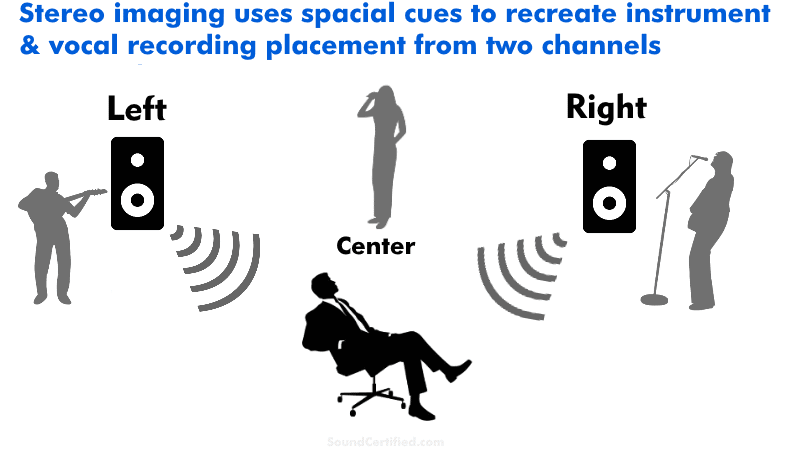
ステレオ イメージングとは、音楽がどのように録音および再生され、音がどこから来ているかを脳に知らせる空間的な手がかりを与える方法を説明するために使用される用語です。たとえば、ミュージシャンによって録音された音楽には、左チャネル、中央、および右チャネルにいくつかの楽器が含まれている場合があります。 ツイーターは高音域のオーディオ キューを再現し、ステレオの「イメージ」を作成するのに役立ちます。
音楽には、私たちの耳に聞こえるほぼすべての範囲でさまざまな音があります。さらに、元のスタジオ楽器と音の配置 (左、右、中央など) を再現できるように、通常はステレオで録音されます。
これにより、サウンド システムで高品質の音楽を聴くときにステレオ イメージングと呼ばれるものが作成されます。
車のツイーター
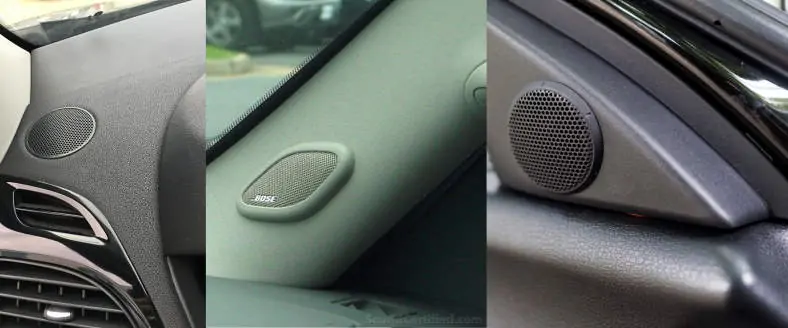
工場で取り付けられた最も典型的なツイーターマウントの3つを示す画像。左:ダッシュボード。中央:ピラーマウント。右:上部ドアを取り付けた状態。ホームステレオスピーカーと同じように、ウーファーなどの他のスピーカーと一緒に使用されます。ツイーターは指向性があり、音量の損失を抑えるため、車内ではより高い位置に取り付けられることがよくあります。
ツイーターは高周波音を発生するため、自動車ではスピーカー システムの一部として使用されますが、単独では使用されません。それらは、コンポーネント スピーカーのような他のものと一緒に使用されるか、既存のものを補完および改善するために使用されます。
より良いサウンドのカー オーディオ システムは、ウーファー スピーカー、1 つまたは複数のパッシブ クロスオーバー、および別のツイーターを使用します。 (車のツイーターには、保護のためにスピーカー グリルが恒久的に取り付けられていることが多いことに注意してください)。
ミッドレンジ ドライバーは、中音域から低音域の周波数を生成します。これらの周波数はより大きな音波を持ち、配置に関してそれほど要求が厳しくありません。ただし、ツイーターは指向性があり、耳に向けたときに最適に聞こえるようになっています。
工場のツイーターは、多くの場合、理想的とは言えない場所に配置されています。これは、車両内のスペースと組立ラインの生産コストとの間の妥協点であるためです。
ツイーターの位置は、高級車やその他のプレミアム サウンド システムを除いて、自動車メーカーではあまり重要視されていません。
カスタム カー ステレオ システムは、多くの場合、カスタム マウントを使用してスペースや取り付け位置の制限を克服することで、最高のサウンドを実現します。さらに、アフターマーケット (非工場) ツイーターは、さまざまな品質レベルで入手できます。これについては後で詳しく説明します。
ツイーターはどのように使用されますか?
スピーカー システムでの一般的な用途
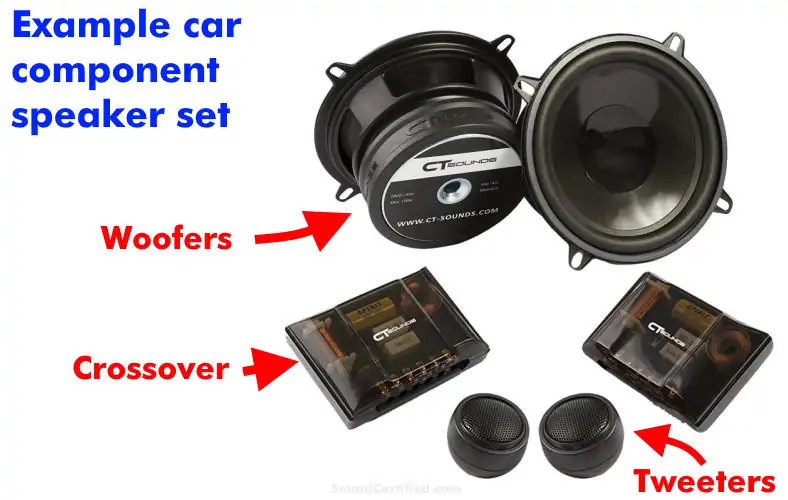
高品質のサウンドを得るには、この CT Sounds Strato カー コンポーネント システムのようなセットを使用できます。コンポーネント スピーカー システムは、通常、スピーカー ワイヤーを介してスピーカー クロスオーバーに接続されたウーファーとツイーターを使用します。
それらはドライバーと個別のサウンド生成を一致させ、最適なドライバーに送信するように設計されています。
ツイーターがスピーカー システムで使用される理由は限られています (単独で使用されることはありません)。
- 2 ウェイまたは 3 ウェイのスピーカー システムでは、他のスピーカーではできないサウンドを生成します
- 効果を高めるために高周波音 (高音) を追加するには
現在使用されているほとんどのスピーカー システムは「2 ウェイ」と呼ばれます。これは、限られた範囲のサウンドを生成する 2 つのスピーカーを組み合わせて使用するためです。これは、現在販売されている単一のコーンを備えたスピーカーで、聞こえる音の全範囲を生成できるものはほとんどないためです.
この主な理由は、大きなスピーカーはより高い (高音) 周波数をうまく生成できず、小さなスピーカーはより大きな (低音) 周波数を生成できないためです.
一般に、スピーカーは特殊化されており、さまざまなサウンドに最適です。
ウーファーのようなミッドレンジ スピーカー (「ミッドバス」スピーカーまたは「ミッド ウーファー」とも呼ばれます) は通常、高音域でひどいパフォーマンスを発揮します。
したがって、ツイーターは、この不足している音域を提供するために重要です。
ツイーターにクロスオーバーが必要な理由
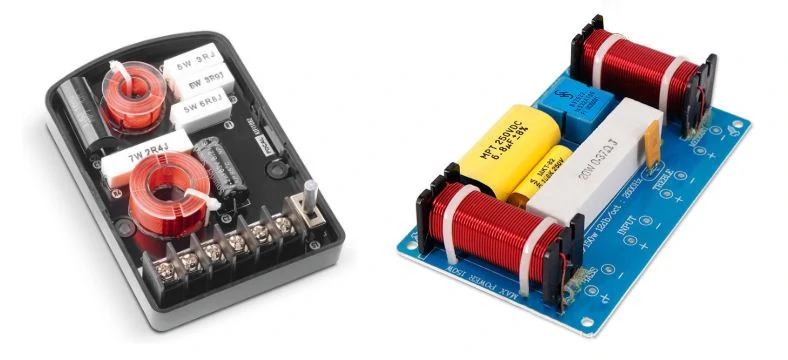
カー スピーカー クロスオーバー (左) とホーム ステレオ スピーカー クロスオーバー (右) は、低音を正しいスピーカーに導く役割を果たします。ツイーターを保護し、歪みをブロックし、低音パワーがオーバードライブするのを防ぎます。
先に述べたように、ツイーターには上の画像のようなクロスオーバーが必要です。それにはいくつかの理由があります。
- ツイーターは低周波音を再生できません - 大きく歪んでしまいます
- 十分に大きな低周波信号または複数の信号がそれらを駆動すると、損傷する可能性があります
- 適用される電力を減らし、それを保護するのに役立ちます
スピーカーのクロスオーバーについて理解する
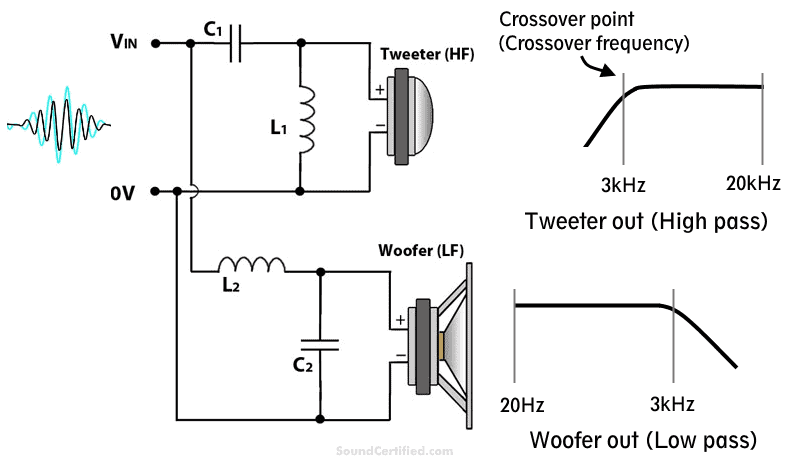
2 ウェイ スピーカー (パッシブ) クロスオーバーは非常に一般的です。ツイーターは、クロスオーバー ポイントより上を通過できるサウンドを受け取ります。示されている 2 ウェイ クロスオーバーは、ハイパス セクションとローパス セクションを組み合わせることによって作成されます。この図では、インダクタ (ワイヤ コイル) を「L」、コンデンサを「C」で示しています。
多くの場合、ツイーターには、配線端子の 1 つと直列に接続された単純なコンデンサーが付属しています。これは通常、慣例によりプラス (+) 端子です。
コンデンサーは、1 次 (1 段) のオーディオ クロスオーバーとして機能します。つまり、オクターブあたり -6 デシベル (dB) の割合で機能するクロスオーバー スロープがあります。オクターブはオーディオに使用される用語で、周波数の 2 倍または 1/2 を表します。たとえば、400 Hz は 200 Hz の 1 オクターブ上です。
高次のクロスオーバーは、ツイーターに到達する低音をさらに除去し、さらに効果的です。 -12dB/オクターブ (2 次) は最も一般的なものの 1 つであり、コストがかからず効果的です。
As you can see in the image above a 2nd order (-12dB) crossover requires an additional component called an inductor. These are coils of wire which react to music and reduce the output to the speaker at certain frequencies.
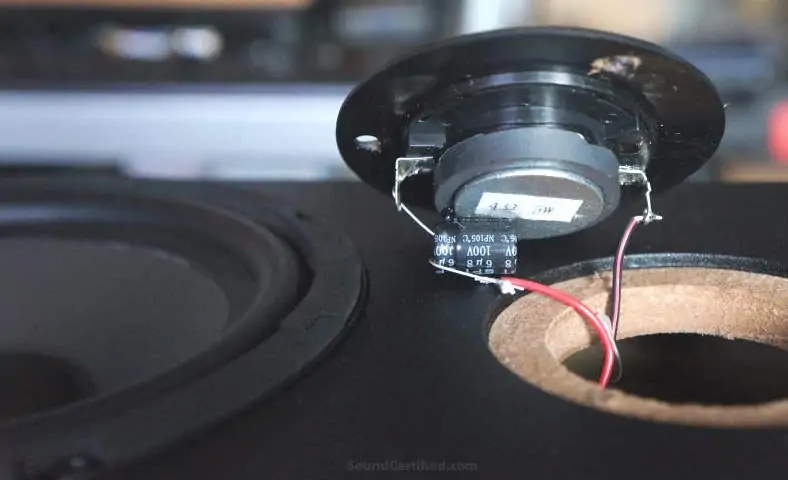
Shown:A typical 2-way home stereo speaker with a tweeter. In this low-cost design, a single capacitor is used in series as a high-pass crossover to filter out bass. This prevents distortion and potential damage to it as well.
What does a tweeter impedance rating mean?
Impedance, rated in Ohms, is a term used to describe the total electrical resistance to current for a speaker. A tweeter’s voice coil is made of a long amount of wire wound into a coil. This wire has electrical resistance.
Impedance is important as crossovers are designed for the rating of your tweeters. Additionally, tweeters should be matched with woofers and other speakers with a similar rating.
If you mismatch speaker impedance one will play at a higher volume than the other as more power drives them. This is because the power developed by a speaker is directly rated to its Ohms rating.
Traditionally, home stereo speakers are rated at 8 ohms while car speakers are typically 4 ohms. What’s interesting is that, for example, 8 ohm speakers aren’t exactly 8 ohms. That’s an approximation as they’re usually somewhat below that (say 6 to 7Ω for example).
Tweeter power ratings
The average tweeter can’t handle large amounts of power as larger speakers can. Woofers and other larger speakers can dissipate larger amounts of heat and have a larger voice coil wiring gauge.
With some exceptions, power ratings like 15W (watts) RMS and above are realistic. 25W-50W is fairly common for mid-priced models sold today.
Tweeters must match the rated impedance expected from an amplifier. Amplifiers can overheat if used with speakers that are too low for their design. (For example:using 4 ohm tweeters with a stereo rated at 8 ohms minimum is not acceptable).
Tweeter efficiency (SPL rating)
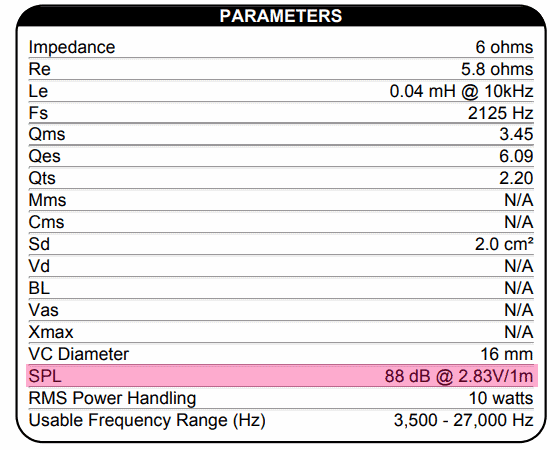
Just like other types of speakers, tweeters have an efficiency rating. This tells you how much volume, in decibels (dB) a tweeter produces for a specific amount of power. This is normally listed as the “SPL” parameter.
In the case of speakers, higher efficiency is better. For average tweeters, you might expect to find this at between 89dB to 91dB at 1W.
Note:dB @ 1W/1m is a standard way of measured speaker efficiency with test equipment with a microphone positioned 1 meter away. However, there are 2 types of tests for this and can be confusing.
It’s important when comparing tweeters to be sure that the measurements are based on similar measurements types. Whenever possible, compare 2 tweeters with measurements based on the same efficiency standard (1W/1M or 2.83V/1M).
The reason for this is that 8 ohm tweeters need a higher voltage applied to create 1W of power as opposed to a 4 ohm model. Similarly, matching tweeters to woofers requires similar care when shopping.
Common tweeter types and materials
材料
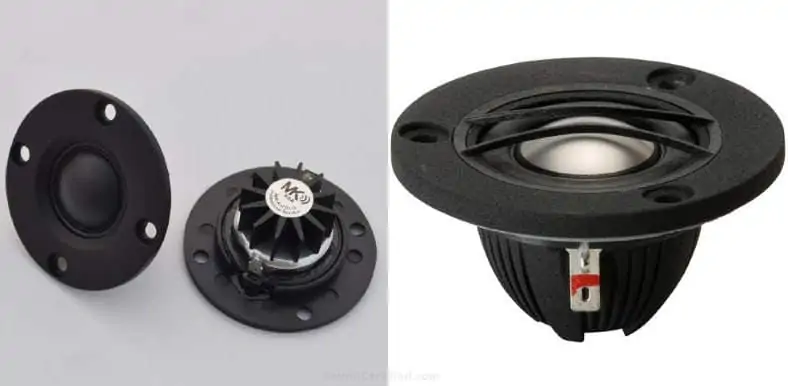
Examples of some of the most common types of tweeters today. A soft dome tweeter (left) is often made with textiles or silk materials as shown. A metal dome tweeter (right) is typically made from aluminum, titanium, or some hybrid design. Some listeners prefer one over the other, although a well-designed tweeter of one type may be able to outperform the other. It’s important to check all the specifications and the frequency response if provided.
There are simply far too many materials used to list here, but I’ll cover some of the most common. Don’t forget that some sold today are made of a variety of less common materials.
Also, it’s important to always check closely as sometimes the specifications aren’t clear and are misleading.
Some of the most common materials used for tweeters include:
- Silk, textile, or other cloth
- Mylar or other plastics
- Metal-coated plastics &PEI materials
- Metals:aluminum, titanium, and alloys
- Ceramics and ceramic-coated domes
- Kapton (in ribbon tweeters)
Silk and textile are some of the most common materials used. Titanium and other types of metals like aluminum are also fairly common for mid-to-upper price range tweeters as well.
Silk tweeters
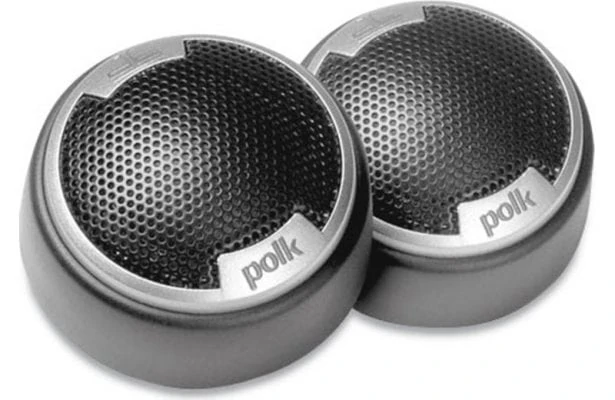
A silk dome tweeter is one of the most popular types and often a good compromise between cost, performance, and sound quality. A great example is this pair of Polk Audio DB1001 car tweeters.
These types tend to perform well and because of their extra stiffness are often associated with a certain “color” of sound. Other special materials like ceramic and even diamond are used in others too.
However, it’s very important to understand that the type of material used for the tweeter dome alone doesn’t determine its quality . You need to always check the specifications such as the frequency response chart if provided.
If none is provided, it’s best to consider seeking out more information and buy a model that provides that information.
Otherwise, you’re taking a gamble with buying a tweeter that’s too “bright” or “harsh” in that it may have certain ranges of sound it emphasizes too much or not enough.
Mylar, PEI, and others
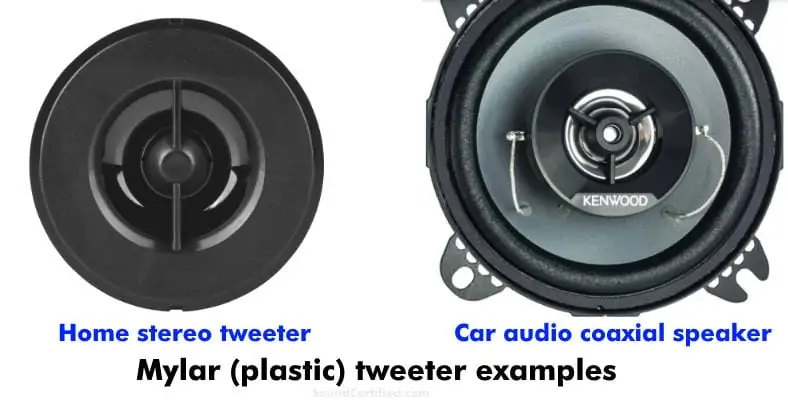
Mylar and PEI types use plastics for the dome. They’re often found in budget component sets or coaxial speakers. While they’re lower cost, they usually aren’t very good for accurate, crisp sound. You can often hear the difference when comparing them directly against a silk dome tweeter pair.
Some models are hybrid and use a type of metal coating that may or may not offer better performance. All of the types listed are usually cone tweeters in how they’re shaped.
Horn and compression horn tweeters
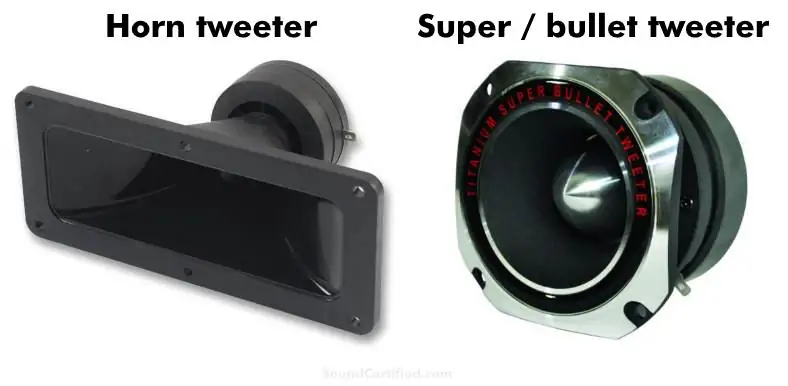
A horn tweeter (left) can driven by a magnet assembly or piezo driver. Piezo tweeters are very loud and efficient but aren’t very good in terms of music quality. A “super tweeter” is usually magnet driven and produces more volume and has a higher power rating than average products. Both are often used for outdoor music events and gatherings.
Horn tweeters are a special class of speakers. Entry-level models like piezo tweeters are inexpensive and not great at producing good musical tones, but they’re cheap and very efficient. Their volume is often much higher than standard tweeters (96dB vs. 91dB produced at 1 watt, for example).
Unlike models that use a magnet, a piezo tweeter uses a piezoelectric crystal coupled to a mechanical diaphragm like a digital watch or electronic clock uses for sound. They usually have a very high impedance and may not even need a crossover. A piezo tweeter is low-cost, efficient (good dB output per watt) but not good for sound quality.
Other horn tweeters used in extremely high-quality home stereos systems have a very good frequency response as well as sound. These are most often “compression horn” type speakers with a magnet and dome that attach to a horn body that expands outward.
This helps to direct the sound more effectively and can radiate sound more evenly than others.
Super tweeter and bullet tweeter models
These are similar to others but may have a “bullet” shape attached to the dome to help produce high sound levels. They’re great for volume and more power handling.
You can use tweeters like these for situations where high power handling and loud volume are the main requirements. For critical listening and enjoyment indoors, they’re normally not very practical.
Ribbon tweeters
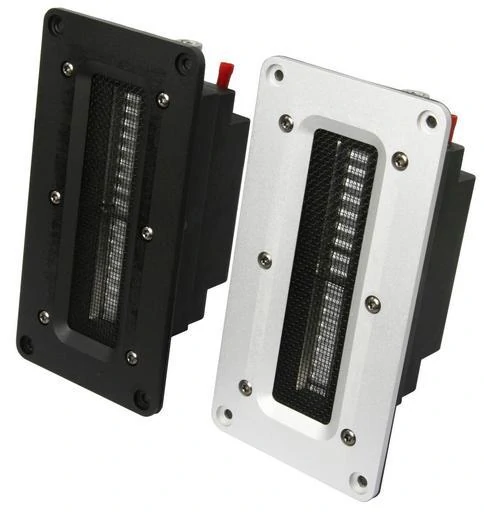
A ribbon tweeter is a bit different from the others. They use a unique design with a very thin “ribbon” diaphragm which moves back and forth in a linear fashion to produce sound.
Tweeters of this type are some of the best and most musical available today, but it depends greatly on the design &quality. Prices range from in about $25 to $600 or so.
One reason they’re so unique is that unlike tweeters based on a voice coil and a magnet, their impedance is much more flat over the frequency response range.
This means there’s less interaction with your crossover due to fluctuations that occur when the audio signal frequency changes.
Ring radiator (concentric) tweeters
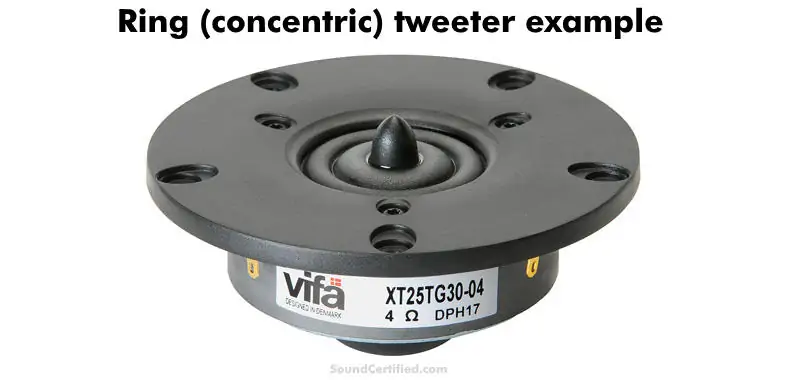
Dual-ring radiator (sometimes called “concentric” ring) tweeters are a unique type of tweeter with a moving surface consisting of several rings and a center plug. These types are more sonically accurate and musically detailed tweeters.
Tweeters of this kind are less common, however.
A downside is that unlike other types they produce far less sound at angles (called the off-axis response ). This means that they’re best suited for speaker systems where they’re aimed directly at the listener.
Tweeter frequency response basics
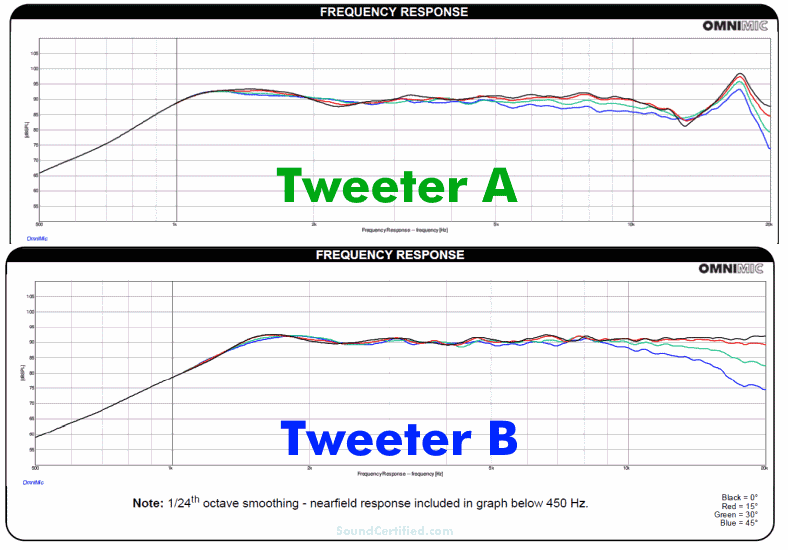
Tweeters have unique characteristics just like any other speaker. In this image, you can see the level of sound produced over different frequencies (called the “response”). These graphics show the sound response at different angles.
In the graphs above we can see that Tweeter A has dips and peaks that will cause the sound to be lacking in some ranges and is too “harsh” (too high) in others. Tweeter B has a much more flat and ideal response, as it’s almost consistently the same over the range of sound produced.
Tweeters, just like any other type of speaker, have limitations. For a given range, they have frequencies at which their response (volume level for a given power applied) is higher or lower than an average decibel (dB) volume produced.
These peaks and valleys (areas where the sound production is higher or falls lower) cannot be overcome without an equalizer or other compensation. Frequencies at the bottom end of the response range are best left to midrange speakers
There’s no such thing as a “perfect” tweeter speaker – they all have good and bad characteristics along with price, mounting, and performance factors to consider.
More great articles you’ll love
- Learn how to reduce tweeter volume with my detailed guide.
- Find out how to wire tweeters with crossovers to an amp.
- Can you hook up tweeters to the same amp as a subwoofer?
- Need to wire them up? You’ll find speaker wiring diagrams and info here.
